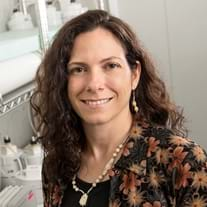Antimicrobial Resistance in the Environment
Amy Pruden’s research examines the spread of antibiotic resistance, a major public health and environmental concern.

The spread of antibiotic resistance is a major public health concern, prompting a movement to reduce their use in food animal production, and prevent resistance buildup in people and the environment.
Amy Pruden, PhD, the W. Thomas Rice Professor in the Department of Civil and Environmental Engineering at Virginia Tech, was among the first researchers to describe antibiotic resistance genes (ARGs) as environmental “contaminants.”
Her research has laid a foundation for understanding why and how agricultural, wastewater, and water environments may represent key pathways for receiving and spreading antimicrobial resistance.
This interview has been edited for space and clarity.
What first led you to investigate water pathways as locations that contribute to the antibiotic resistant genes burden?
As a new faculty member at Colorado State University, there was this growing awareness of emerging pollutants – the trace chemicals that end up in our water. Things like pharmaceuticals, personal care products, etc.
Things that in the past, we thought, ‘Oh, it goes down the drain and it goes away,’ or, ‘I took that pill, it’s gone. My body broke it down.’ Now we know that isn’t the case.
At the time, my collaborator, Dr. Ken Carlson had begun looking at antibiotic residuals in Colorado’s Poudre River. Ken is a water chemist and had developed techniques to look for pharmaceuticals at trace levels in environmental water samples. He was able to distinguish between antibiotics typically found in livestock and in people.
This led me to think, ‘Antibiotics in the environment might not be much of a concern, unless they’re influencing the resident microbial communities and stimulating the spread of antibiotic resistance.’ At the same time, I was well-aware of the complexity of microbial communities in the environment and that culture-based methods would only provide information about a small fraction of a percent of the bacteria in the river.
It all came together, if we wanted to understand antibiotic resistance in these river sediments, we had to use the DNA-based tools, and not look at one culture or strain at a time.
What are some of the practical challenges of your work?
A big challenge is the lack of a standard agreed upon method for monitoring antibiotic resistance in the environment. Most of the antibiotic resistance work that’s been done, has been done in the clinic, but the single strain-based diagnostic methods used there are not necessarily appropriate for environmental monitoring.
Ideally, what is needed are tools and metrics that capture microbial ecological dimensions of antibiotic resistance, including types, mechanisms, and magnitudes of ARGs, and their potential to spread.
Assessing the potential for bacteria to share their ARGs, which they can do within and among members of microbial communities via horizontal gene transfer, is especially key.
Currently we’re working on methods using next-generation DNA sequencing and bioinformatics analysis to gain a holistic “resistome” perspective: a full sense assessment of all the ARGs that are present, along with mobile genetic elements, like plasmids, transposons, and integrons and things that may facilitate development of multi-drug resistance and the capacity for ARGs to spread among bacteria.
How can we better control the spread of antibiotic resistance genes?
We need to get at the root causes, understanding how antibiotic resistance evolves and spreads in the first place. Identifying hotspots can be a useful way to achieve this.
A hotspot is a place where many factors come together to increase the chances that antibiotic-resistant pathogens can evolve. For example, wastewater treatment plants are potential hotspots, because they bring together everything that’s flushed down the drain, pathogens, ARGs, and antibiotics. Hotspots would be a useful target both for monitoring and mitigation.
The other big area is in agriculture. The majority of antibiotics used in the world, are for agriculture and livestock. Yet, we don’t have wastewater treatment plants on farms – that would be too costly and impractical.
Instead, there are opportunities to improve manure management. For this to work, we need simple, practical guidelines, that determine which antibiotics best protect livestock, but have the least effect on human health and lesser environmental impact. Then we need to decide how to handle manure from livestock treated with antibiotics.
Should it be composted or digested? What are the safest practices for land application as a soil amendment?
Also read: Getting Out the Facts on Public Health
Warning: Undefined variable $showit in /var/www/nyas_develop/nyas/public/wp-content/themes/nyas-theme-child/includes/shortcodes.php on line 1802
